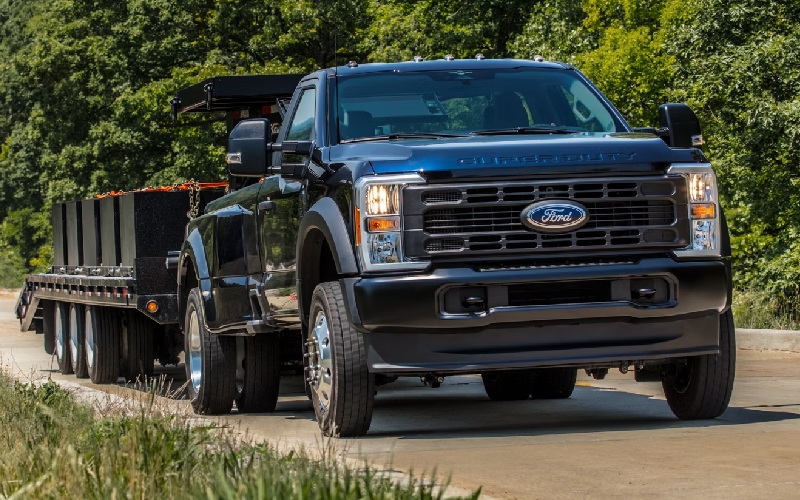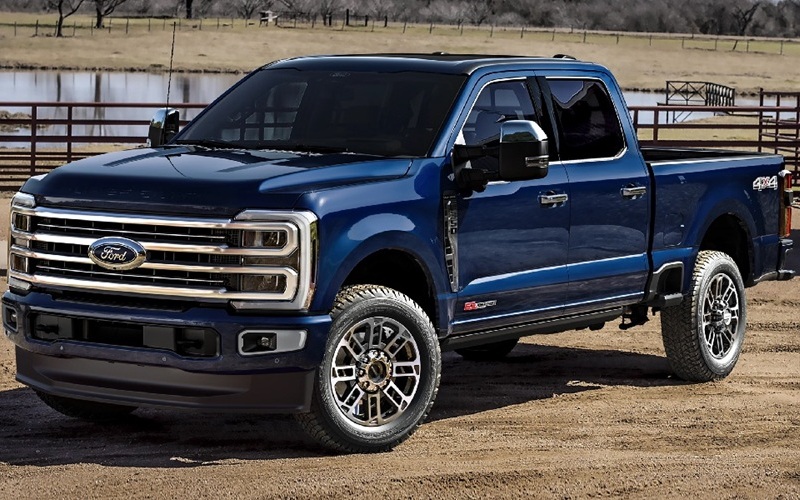The Ford Ranger continues the model’s tradition of offering robust and versatile powertrain options to suit various driving needs, from everyday commuting to serious off-road adventures and heavy-duty towing. The latest iteration of the Ford midsize pickup presents a refined selection of engines that balance power, efficiency, and capability, each engineered to deliver the performance characteristics different Ranger owners prioritize.

2.3-Liter EcoBoost: The Versatile Foundation
The 2.3-liter EcoBoost four-cylinder engine continues as the standard powerplant for most Ranger models, delivering an impressive balance of power and efficiency that suits a wide range of driving scenarios.
Technical Specifications
- Engine Type: Turbocharged inline-four with direct injection
- Displacement: 2,261 cc
- Bore x Stroke: 87.5 mm x 94.0 mm
- Compression Ratio: 10.0:1
- Power Output: 201 kW (270 horsepower) at 5,500 rpm
- Torque: 420 Nm (310 lb-ft) from 2,500-4,500 rpm
- Redline: 6,500 rpm
- Block/Head Material: Aluminum block and head
- Valvetrain: DOHC, 16 valves with variable intake valve timing
- Forced Induction: Twin-scroll turbocharger with electronic wastegate
Ford engineers have refined the EcoBoost calibration to improve throttle response at lower rpm, addressing feedback from previous Ranger owners who desired more immediate power delivery during everyday driving scenarios. The updated engine management system also features enhanced torque mapping, providing more consistent performance under varying load conditions.
Performance Characteristics
The 2.3-liter EcoBoost delivers impressive real-world performance metrics:
- 0-100 km/h Acceleration: 7.4 seconds (4×2 configuration)
- 50-80 km/h Passing Time: 3.2 seconds
- Maximum Towing Capacity: 3,402 kg (properly equipped)
- Maximum Payload Capacity: 945 kg
This engine’s broad torque band suits it well for urban driving and moderate towing duties. The twin-scroll turbocharger design minimizes lag, delivering 90% of peak torque from just 2,000 rpm, providing the low-end response traditionally associated with larger-displacement engines.
Fuel Efficiency
Fuel economy ratings for the 2.3-liter EcoBoost demonstrate its efficiency advantages:
- City Driving: 11.8 L/100 km (4×2), 12.4 L/100 km (4×4)
- Highway Driving: 9.4 L/100 km (4×2), 10.2 L/100 km (4×4)
- Combined Cycle: 10.7 L/100 km (4×2), 11.4 L/100 km (4×4)
The latest model benefits from updated direct injection hardware and refined engine mapping that improves combustion efficiency, yielding approximately 3% better fuel economy than the previous model year. The engine also features advanced start-stop technology that seamlessly deactivates the engine during extended idle situations, further enhancing real-world efficiency.
Ideal Applications
The 2.3-liter EcoBoost is best suited for:
- Daily driving and commuting
- Light to moderate towing (trailers, boats under 2,500 kg)
- Owners prioritizing a balance of power and fuel efficiency
- Fleet applications where operating costs are a primary consideration
3.0-Liter Power Stroke V6 Diesel: The Torque Leader
The Ranger now offers the 3.0-liter Ford Power Stroke V6 diesel engine, bringing exceptional torque and efficiency to the midsize pickup segment.
Technical Specifications
- Engine Type: Turbocharged V6 diesel with direct injection
- Displacement: 2,993 cc
- Bore x Stroke: 84.0 mm x 90.0 mm
- Compression Ratio: 16.0:1
- Power Output: 184 kW (247 horsepower) at 3,250 rpm
- Torque: 600 Nm (443 lb-ft) from 1,750-2,500 rpm
- Redline: 4,500 rpm
- Block/Head Material: Compacted graphite iron block, aluminum heads
- Valvetrain: DOHC, 24 valves
- Forced Induction: Variable-geometry turbocharger
- Emissions Control: Selective Catalytic Reduction (SCR) with Diesel Exhaust Fluid (DEF)
This engine represents a significant addition to the Ranger lineup, importing technology from larger Ford trucks while optimizing it for the midsize platform. Compared to traditional cast iron, the compacted graphite iron block provides exceptional strength while reducing noise, vibration, and harshness (NVH).
Performance Characteristics
The Power Stroke diesel delivers impressive capability metrics:
- 0-100 km/h Acceleration: 8.2 seconds
- 50-80 km/h Passing Time: 3.6 seconds
- Maximum Towing Capacity: 3,855 kg (properly equipped)
- Maximum Payload Capacity: 921 kg
While the diesel’s acceleration figures aren’t quite as quick as the 2.3-liter EcoBoost, its prodigious torque, delivered at exceptionally low rpm, makes it feel more responsive in real-world driving scenarios, particularly when loaded or towing. The variable-geometry turbocharger virtually eliminates traditional turbo lag, providing immediate response when accelerating from a stop.
Fuel Efficiency
The 3.0-liter Power Stroke demonstrates exceptional efficiency:
- City Driving: 10.7 L/100 km (4×2), 11.2 L/100 km (4×4)
- Highway Driving: 8.1 L/100 km (4×2), 8.7 L/100 km (4×4)
- Combined Cycle: 9.5 L/100 km (4×2), 10.1 L/100 km (4×4)
The diesel Ranger is ideal for long-distance travel with a driving range exceeding 1,000 kilometers on a single 80-liter tank under optimal conditions. The engine also features a dual-circuit cooling system that allows faster warm-up in cold conditions, improving efficiency and emissions performance during winter operation.
Ideal Applications
The 3.0-liter Power Stroke is particularly well-suited for:
- Frequent towing of heavier loads
- Long-distance highway driving
- Off-road adventures requiring low-end torque
- Work applications requiring maximum torque and efficiency
- Owners who cover high annual mileage
2.7-Liter EcoBoost V6: The Performance Option
The 2.7-liter EcoBoost V6 is the performance-oriented option in the Ford Ranger lineup, delivering impressive power for buyers who prioritize acceleration and responsiveness.
Technical Specifications
- Engine Type: Twin-turbocharged V6 with direct injection
- Displacement: 2,694 cc
- Bore x Stroke: 83.0 mm x 83.0 mm
- Compression Ratio: 10.3:1
- Power Output: 231 kW (310 horsepower) at 5,500 rpm
- Torque: 542 Nm (400 lb-ft) from 2,750-4,000 rpm
- Redline: 6,250 rpm
- Block/Head Material: Compacted graphite iron block, aluminum heads
- Valvetrain: DOHC, 24 valves with variable valve timing
- Forced Induction: Twin turbochargers
This engine receives enhanced cooling capacity and a revised air intake system that improves airflow during high-load conditions. The compacted graphite iron block—typically found in heavy-duty applications—provides exceptional rigidity that contributes to refinement while handling the substantial forces generated by the twin turbochargers.
Performance Characteristics
The 2.7-liter EcoBoost delivers impressive performance metrics:
- 0-100 km/h Acceleration: 6.5 seconds
- 50-80 km/h Passing Time: 2.8 seconds
- Maximum Towing Capacity: 3,629 kg (properly equipped)
- Maximum Payload Capacity: 889 kg
This engine provides near-sport-truck performance in certain configurations, particularly in the Ranger Wildtrak and Tremor models, paired with performance-oriented suspension tuning. The twin-turbo setup delivers exceptional responsiveness throughout the rev range, with minimal perceptible lag even from a standstill.
Fuel Efficiency
Despite its performance focus, the 2.7-liter EcoBoost maintains reasonable efficiency:
- City Driving: 12.8 L/100 km (4×2), 13.5 L/100 km (4×4)
- Highway Driving: 10.2 L/100 km (4×2), 10.9 L/100 km (4×4)
- Combined Cycle: 11.6 L/100 km (4×2), 12.3 L/100 km (4×4)
The engine incorporates enhanced thermal management that improves warm-up times and overall efficiency. The direct injection system delivers more precise fuel metering across varying load conditions, improving performance and economy.
Ideal Applications
The 2.7-liter EcoBoost V6 is best suited for:
- Performance-oriented drivers
- Towing in mountainous terrain
- High-speed highway driving
- Owners who value quick acceleration and responsive throttle
- Off-road enthusiasts requiring both low-end torque and high-end power
Transmissions and Driveline Options
10-Speed Automatic Transmission
All Ranger engine options come paired with sophisticated 10-speed automatic transmission:
- Gear Ratios:
- 1st: 4.696
- 2nd: 2.985
- 3rd: 2.146
- 4th: 1.769
- 5th: 1.520
- 6th: 1.275
- 7th: 1.000
- 8th: 0.854
- 9th: 0.689
- 10th: 0.636
- Reverse: 4.866
- Features:
- Adaptive shift scheduling
- Progressive Range Selection
- Real-time adaptive shift algorithms
- Tow/Haul mode with enhanced engine braking
- SelectShift manual mode with steering wheel-mounted paddles
- Electronic rotary shift dial
The transmission receives updated shift mapping specific to each engine, optimizing shift points for the unique power and torque curves of the different powerplants. The diesel variant features specialized programming that maximizes the low-end torque characteristics of the Power Stroke engine.
Drive Systems
The Ford Ranger offers two drive system configurations:
Rear-Wheel Drive (4×2)
- Standard on most base configurations
- Electronic locking rear differential available
- Lighter weight improves fuel economy and payload capacity
Four-Wheel Drive (4×4)
- Electronic shift-on-the-fly system
- 2H, 4H, and 4L modes
- Available electronic locking rear differential
- Optional advanced terrain management system with multiple drive modes
The 4×4 system has been enhanced with improved electronic control that provides faster engagement and more seamless transitions between drive modes. Models equipped with the terrain management system receive updated calibrations for each drive mode, optimizing power delivery and traction control intervention based on surface conditions.
Engine-Specific Technologies and Features
2.3-Liter EcoBoost
- Auto Start-Stop: Refined with smoother restart characteristics
- Active Grille Shutters: Improve aerodynamics at highway speeds
- Twin-Scroll Turbocharger: Separates exhaust pulses for improved response
- Integrated Exhaust Manifold: Improves warm-up times and reduces weight
3.0-Liter Power Stroke Diesel
- Two-Stage Oil Pump: Varies pressure based on engine demands
- Common-Rail Fuel Injection: 2,000 bar injection pressure
- Ceramic Glow Plugs: Faster start times in cold weather
- Water-Cooled Charge Air Cooler: Maintains consistent intake temperatures
- Diesel Exhaust Fluid System: 18-liter capacity for extended service intervals
2.7-Liter EcoBoost V6
- Dual Water-to-Air Intercoolers: Provide consistent charge cooling
- Port and Direct Fuel Injection: Dual system optimizes performance and efficiency
- Variable-Displacement Oil Pump: Reduces parasitic losses
- Twin Independent Variable Camshaft Timing: Optimizes valve events across the rev range
Fuel System and Requirements
Each engine has specific fuel requirements and system characteristics:
2.3-Liter EcoBoost
- Recommended Fuel: 91 RON (premium) for maximum performance; 87 RON (regular) acceptable
- Fuel Tank Capacity: 80 liters
- Approximate Range: 747 kilometers (combined cycle, 4×2)
3.0-Liter Power Stroke Diesel
- Recommended Fuel: Ultra-low sulfur diesel
- Fuel Tank Capacity: 80 liters
- DEF Tank Capacity: 18 liters
- DEF Refill Interval: Approximately 10,000 kilometers
- Approximate Range: 842 kilometers (combined cycle, 4×2)
2.7-Liter EcoBoost V6
- Recommended Fuel: 91 RON (premium) for maximum performance; 87 RON (regular) acceptable
- Fuel Tank Capacity: 80 liters
- Approximate Range: 690 kilometers (combined cycle, 4×2)
Maintenance Considerations
Each engine option presents different maintenance requirements and considerations:
2.3-Liter EcoBoost
- Oil Change Interval: 10,000 kilometers or 12 months
- Recommended Oil: SAE 5W-30 synthetic blend
- Oil Capacity: 5.4 liters with filter
- Spark Plug Replacement: 100,000 kilometers
- Timing Belt/Chain: Maintenance-free timing chain
3.0-Liter Power Stroke Diesel
- Oil Change Interval: 12,000 kilometers or 12 months
- Recommended Oil: SAE 5W-30 full synthetic
- Oil Capacity: 8.5 liters with filter
- Fuel Filter Replacement: 24,000 kilometers
- DEF Refill: Approximately every 10,000 kilometers
2.7-Liter EcoBoost V6
- Oil Change Interval: 8,000 kilometers or 12 months
- Recommended Oil: SAE 5W-30
- Oil Capacity: 6.0 liters with filter
- Spark Plug Replacement: 100,000 kilometers
- Timing Belt/Chain: Maintenance-free timing chain
2025 Ford Ranger: Select the Optimal Engine
The diverse engine lineup of the Ford Ranger offers options tailored to different priorities and use cases. The standard 2.3-liter EcoBoost delivers a well-rounded balance of performance and efficiency suitable for most buyers. Those requiring maximum towing capability and efficiency, particularly for long-distance travel, will find the new 3.0-liter Power Stroke diesel compelling despite its higher initial investment. Performance-oriented drivers and those who frequently tow in challenging conditions will appreciate the additional power and responsiveness of the 2.7-liter EcoBoost V6.
Each engine integrates sophisticated technologies that enable it to deliver capability that would have required much larger displacement in previous generations. The 10-speed automatic transmission further enhances the performance and efficiency of all three options, providing optimized gear selection for any driving scenario.
By offering this diverse powertrain portfolio, Ford ensures that the Ford Ranger can be configured to meet the specific needs of a wide range of pickup truck buyers, from commercial users to weekend adventurers and everyone in between.






